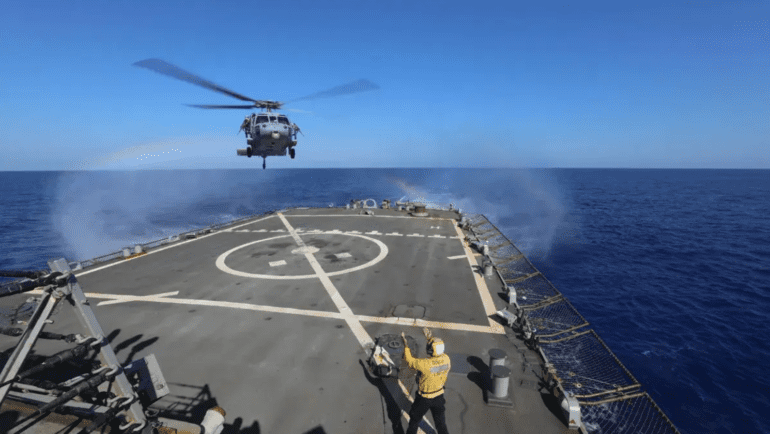TL;DR:
- Helicopter landings on ships are complex and challenging due to dynamic conditions.
- Traditional methods involve using a horizon bar for alignment with the ship’s motion.
- Previous attempts at automation relied on cameras, GPS, and lidar, with limited success.
- The U.S. Navy and Texas A&M University are collaborating on a project to revolutionize autonomous VTOL technology.
- The focus is on a trained machine-learning algorithm and optimal aircraft design.
- Reinforcement learning enables precise tracking even in adverse conditions.
- Research by Dr. Moble Benedict and Dr. Dileep Kalathil demonstrates successful unmanned aerial systems (UAS) landings.
- Customized VTOL designs and robust algorithmic solutions are central to the project.
- The U.S. Navy aims for a triple-threat aircraft—runway-independent, fuel-efficient, and capable of automated ship landings.
- Collaboration between aerospace and electrical engineering is driving innovation.
- The project’s impact extends to swarm intelligence in naval operations.
Main AI News:
In the realm of naval aviation, orchestrating the delicate art of landing a helicopter on the deck of a moving ship is no ordinary feat—it’s a high-stakes performance tightly synchronized with the capricious forces of nature. Navigating through gusty winds, shifting seas, diminished visibility, and an array of demanding conditions, it’s hardly surprising that the realm of automated solutions has encountered its fair share of obstacles. Traditionally, the key lies in the pilot’s mastery of not fixating on the ship’s dynamic deck, but rather on a specialized instrument known as the horizon bar. This reference point helps align the helicopter’s motion with the ship’s, ensuring a secure landing.
Past endeavors to automate this intricate process have leaned on technologies like cameras, GPS, and lidar to monitor the ship’s deck and modify the aircraft’s trajectory accordingly. However, these methods have faltered in turbulent environments, struggling to adapt swiftly to abrupt shifts in the ship’s course and speed.
Yet, envision a world where machine learning banishes these challenges to the annals of history. Enter a groundbreaking initiative spearheaded by the U.S. Navy—a mission poised to revolutionize the landscape of autonomous vertical takeoff and landing (VTOL) technology.
Elevating Maritime Aviation: The Ascension of Machine Learning
The U.S. Navy is embarking on an ambitious quest to engineer a future where helicopters elegantly touch down on ships sans human intervention. A collaborative endeavor has been forged with the esteemed minds at Texas A&M University, where researchers are engaged in fashioning a pioneering solution.
In an official statement, the Navy unveiled an innovative approach centered around fusing optimal aircraft design with a meticulously trained machine-learning algorithm. The crux of this endeavor is to achieve the Holy Grail of aviation: fully autonomous aircraft landings.
Decoding the Horizon Bar Enigma
Dr. Moble Benedict, an illustrious figure in the Department of Aerospace Engineering at Texas A&M, unveiled an intriguing aspect of helicopter piloting—pilots’ gaze doesn’t fixate on the moving deck. Instead, their focus centers on a specialized instrument christened the ‘horizon bar.’ This luminous, gyro-stabilized strip serves as an artificial horizon, granting pilots a steadfast point of reference.
While predecessors concentrated their efforts on capturing the ship’s ever-shifting deck using cameras, GPS, and lidar, Dr. Benedict and his counterpart, Dr. Dileep Kalathil, charted a new trajectory. Their innovation hinges on emulating a pilot’s conduct by directing attention to the horizon bar, and it’s guided by a process known as reinforcement learning.
The Algorithmic Ballet: Reinforcement Learning
What sets their approach apart? The answer lies in “reinforcement learning,” a cornerstone of machine learning that underpins the algorithm orchestrating autonomous systems. According to Dr. Kalathil, an adept mind from the Department of Electrical and Computer Engineering, their algorithm is meticulously refined. Even in the face of vehicular course changes and formidable winds, it remains poised to trace the horizon bar with exceptional precision.
The marriage of aerospace and electrical engineering isn’t a mere abstraction—it’s a tangible reality. Dr. Benedict and Dr. Kalathil have already demonstrated their innovation’s efficacy by expertly guiding unmanned aerial systems (UAS) to safe landings across challenging landscapes, spanning from windswept terrains to fog-draped vistas.
Crafting Futuristic Aircraft Designs
Dr. Benedict is lending his prowess in rotorcraft expertise to sculpt VTOL aircraft engineered to endure gusty winds while optimizing efficiency. These designs might even encompass foldable wings, ensuring a seamless transition from vertical takeoff to fixed-wing cruising. Rigorous simulations, wind-tunnel tests, and real-world flights will scrutinize their viability.
Conversely, Dr. Kalathil is focusing on fortifying algorithmic solutions. “The crux lies in taming the capricious seas,” he revealed, disclosing plans to deploy wind sensors for real-time adjustments. This tactical maneuver aims to bridge the divide between simulations and reality that once posed a stumbling block.
A Threefold Triumph: Naval Aviation’s Future
The U.S. Navy is in pursuit of a three-pronged aspiration—a runway-independent, fuel-efficient aircraft capable of autonomously landing on a ship in motion. Funded by the U.S. Navy, this ambitious three-year venture stands poised to fulfill this aspiration.
Collaboration is the beating heart of this endeavor. Dr. Benedict and Dr. Kalathil, instead of working in silos, are fostering interdisciplinary synergy. Dr. Kalathil envisions a collaborative console that could govern multiple UASs, heralding the dawn of swarm intelligence in naval operations.
Conclusion:
The collaboration between the U.S. Navy and Texas A&M University signifies a pivotal step towards transforming naval aviation. By harnessing the power of machine learning, the project addresses the intricate challenges of shipboard helicopter landings. With an emphasis on algorithmic precision and innovative aircraft design, this endeavor has the potential to reshape not only naval operations but also pave the way for advancements in autonomous technology across various sectors of the market.

